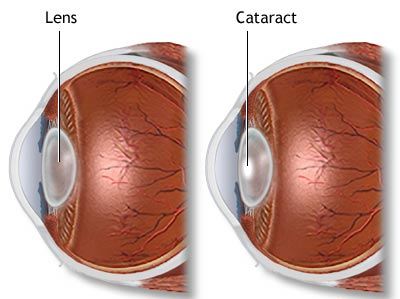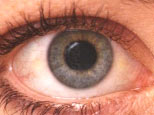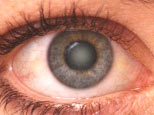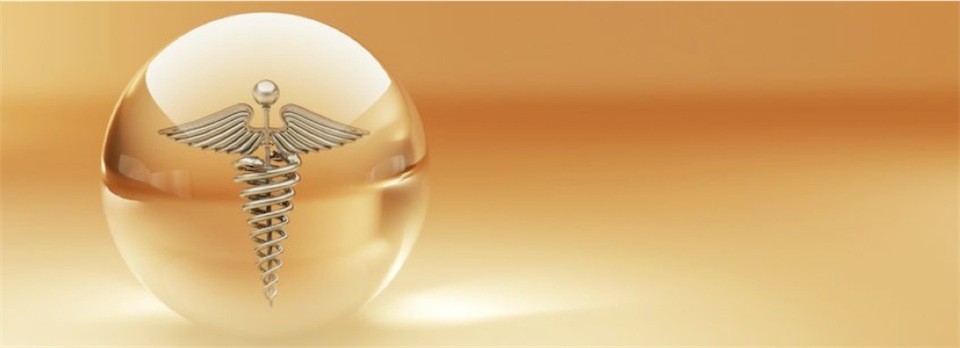WHAT
IS A CATARACT?
A cataract is a clouding of the lens of the eye. To understand what
a cataract is, it's helpful to know that the lens is a clear, oval
structure with three layers: nucleus, cortex and capsule. The analogy
of a peach can be used to describe these layers. The nucleus or
center of the lens is the pit of the peach, the cortex is the flesh
surrounding the pit, and the capsule or elastic covering is the
skin of the peach. The lens is supported inside the eye by tiny
ligaments (zonules) that support the lens capsule.



Eye
with no cataract. Eye
with cataract.
In a young person, the lens is crystal clear and allows light to
pass through and focus on the retina. As the lens ages, the nucleus
turns yellow and loses its ability to accommodate (focus for close
work) although the lens usually remains clear. As the lens continues
aging, the nucleus turns from yellow to amber and ultimately to
brown. Aging changes do not necessarily result in a cataract unless
the nucleus becomes opaque, or opacities that block or scatter light
develop in the cortex or under the capsule.

Now
you see it.
Now you don't.
December
29th - Steroids, the legal kinds, such as Prednisone and Cortisone,
are strong anti-inflammatory drugs that are helpful to people who
suffer from serious diseases such as asthma, emphysema, arthritis,
ulcerative colitis, eczema, lupus and multiple sclerosis. Whether
taken orally, topically (for eyes) or via an inhaler, these are
potent drugs that can reduce inflammation, control disease flare-ups,
and sometimes even prevent death. But used too frequently and/or
for long periods, they can lead to side effects in a variety of
organs, including the eye.
WEIGHING THE BENEFITS AND THE RISKS
To limit side effects, oral, inhaled or topical ophthalmological
steroids are often prescribed for a very short period of time. However,
for many serious conditions, they must be used for longer periods
of time. Chronic use of steroids can cause many well-known side
effects, including weakened bones, fluid retention, high blood pressure,
mood swings and confusion. Less well known is that they can also
cause eye problems such as cataracts and glaucoma, notes David F.
Chang, MD, a clinical professor of ophthalmology at the University
of California, San Francisco and coauthor of Cataracts: A Patient's
Guide to Treatment. The good news is that cataracts are very treatable,
as is glaucoma when detected early. Before prescribing steroids,
Dr. Chang points out that doctors always try to make sure that the
benefits of treatment outweigh the risks and disadvantages, and
generally will limit their use to as short a time as possible.
Ophthalmologists themselves use steroid eye drops to treat a variety
of potentially serious eye conditions, such as severe inflammation
and to prevent rejection of corneal transplants. Other physicians
may prescribe them for other reasons, for instance to reduce the
severe itching caused by hay fever and allergies. However, because
of the potential for cataracts and glaucoma, patients should be
under an ophthalmologist's care and supervision in these situations.
Finally, even steroid inhalers commonly prescribed for asthma and
emphysema, such as Flovent and Advair, have the potential to cause
cataracts and glaucoma. That these low-dose, frequently used steroid
inhalers could potentially cause eye problems may come as a surprise
to many people.
USE
STEROIDS SAFELY
Here
are some guidelines for safe usage:
 Patients taking
steroid pills or inhalers for chronic conditions should have a yearly
eye exam. This is the best way to diagnose treatable problems such
as cataracts and glaucoma, Dr. Chang emphasizes. For example, glaucoma
has no early symptoms, so people may not realize it is developing
-- or that early treatment with eye drops may be necessary to prevent
permanent vision loss.
Patients taking
steroid pills or inhalers for chronic conditions should have a yearly
eye exam. This is the best way to diagnose treatable problems such
as cataracts and glaucoma, Dr. Chang emphasizes. For example, glaucoma
has no early symptoms, so people may not realize it is developing
-- or that early treatment with eye drops may be necessary to prevent
permanent vision loss.
 If you require
chronic steroid medication, ask your prescribing doctor what side
effects you should watch for. If you already have glaucoma, notify
your ophthalmologist if you end up needing steroids in the form
of an inhaler or pills for a prolonged period of time.
If you require
chronic steroid medication, ask your prescribing doctor what side
effects you should watch for. If you already have glaucoma, notify
your ophthalmologist if you end up needing steroids in the form
of an inhaler or pills for a prolonged period of time.
 If you are using
steroid inhalers or pills, carefully follow your prescribing doctor's
instructions. He/she will generally want you to take the lowest
effective dose for the shortest possible time. It is particularly
important not to self-medicate with steroids, including eye drops
containing steroids. These should always be used under the supervision
of your doctor.
If you are using
steroid inhalers or pills, carefully follow your prescribing doctor's
instructions. He/she will generally want you to take the lowest
effective dose for the shortest possible time. It is particularly
important not to self-medicate with steroids, including eye drops
containing steroids. These should always be used under the supervision
of your doctor.
 Do not abruptly
stop taking oral steroids or using inhalers on your own. Withdrawal
usually must be phased gradually, and stopping them too quickly
may lead to serious medical problems. If you are experiencing side
effects, discuss this with your prescribing physician rather than
deciding on your own to stop them or reduce the dose.
Do not abruptly
stop taking oral steroids or using inhalers on your own. Withdrawal
usually must be phased gradually, and stopping them too quickly
may lead to serious medical problems. If you are experiencing side
effects, discuss this with your prescribing physician rather than
deciding on your own to stop them or reduce the dose.
 Follow an anti-inflammatory
diet. To fight inflammation, eat more nutrient-rich fresh fruits
and vegetables (deeply colored blueberries and cranberries, dark
green leafy chard and mustard greens, for instance). Cold-water
fish such as salmon and tuna is rich in inflammation-fighting omega-3
fatty acids. Cut back on simple sugars and carbohydrates from processed
foods (cookies, white bread, chips) and fast foods, which cause
extreme fluctuations in blood glucose levels ... and fried foods
(particularly those with trans fat such as French fries), which
encourage inflammation.
Follow an anti-inflammatory
diet. To fight inflammation, eat more nutrient-rich fresh fruits
and vegetables (deeply colored blueberries and cranberries, dark
green leafy chard and mustard greens, for instance). Cold-water
fish such as salmon and tuna is rich in inflammation-fighting omega-3
fatty acids. Cut back on simple sugars and carbohydrates from processed
foods (cookies, white bread, chips) and fast foods, which cause
extreme fluctuations in blood glucose levels ... and fried foods
(particularly those with trans fat such as French fries), which
encourage inflammation.
Steroids -- whether as pills, inhalers or eye drops -- should be
reserved for serious illnesses. The dramatic benefits can make them
seem like wonder drugs, but your doctor must always weigh the benefits
against the potential side effects.
Source(s):
David F. Chang, MD, clinical professor of ophthalmology, University
of California, San Francisco, and coauthor of Cataracts: A Patient's
Guide to Treatment (Addicus). Dr. Chang is chair of the Cataract
Committee of the American Society of Cataract and Refractive Surgery
EYE
DISEASES
PREVENTION CAN BE THE ANSWER
HERE'S WHAT YOU CAN DO TO STAY HEALTHIER
It
has become clear in recent years that nutritional deficiencies are
the root cause of many of our illnesses. The following is list of
vitamins and supplements that are absent in many people's diets.
It is in alphabetical order and not necessarily in the order of
importance for you.
 Essential Nutrient
#1: Alpha-Lipoic Acid
Essential Nutrient
#1: Alpha-Lipoic Acid
2006 may as well have been the "Year of the Antioxidant."
The latest research has discovered these substances, which prevent
or impede cell oxidation (destruction) by free radicals, in everything
from red wine to blueberries to chocolate.
Alpha-lipoic acid, ALA, has been called the "universal,"
"ideal," and "ultimate" antioxidant. According
to the UC Berkeley Wellness Letter, "What makes ALA special
as an antioxidant is its versatility - it helps deactivate an unusually
wide array of cell-damaging free radicals in many bodily systems."
ALA also helps "recycle" vitamins C and E and other antioxidants,
thus making them much more effective.
ALA is thought to be a powerful weapon in the fight against the
oxidative stress we encounter as we age. The incidence of eye problems
such as macular degeneration, cataracts and pterygium (a fleshy
growth on the cornea that can impede vision) increase dramatically
as we age due to free-radical damage from factors such as smoking,
poor nutrition, and exposure to ultraviolet (UV) light.
 Essential Nutrients
#2 & #3: Bilberry and Bioflavonoids
Essential Nutrients
#2 & #3: Bilberry and Bioflavonoids
Bilberry is thought to improve night vision. A close relative of
the cranberry, bilberry is high in a certain type of bioflavonoid
that speeds the regeneration of rhodopsin, the purple pigment used
by the eyes' rods. British air force pilots in World War II ate
bilberry jam to improve their night vision during evening sorties.
Bilberry fruits, found in the forest meadows of Europe, western
Asia, and the northern Rocky Mountains, contain flavonoid compounds
called anthocyanidins.
Flavonoids are plant pigments that have excellent antioxidant properties;
they have been shown to help prevent a number of long-term illnesses
such as heart disease, cancer, and macular degeneration, the leading
cause of vision loss and legal blindness in Americans age 65 and
older, according to the eye-health organization Prevent Blindness
America.
 Essential Nutrient
#4: Chromium
Essential Nutrient
#4: Chromium
Dr. Benjamin C. Lane, O.D., from the Nutritional Optometry Institute
in New Jersey, says, “Americans are getting less chromium
and much more of its major antagonist, vanadium (a trace element)
because of recent dietary trends to large marine fish and poultry.”
In numerous tissue testing and diet assessment studies that Dr.
Lane has performed over the past twenty years he has found that
“low levels of chromium are a major risk factor for increased
intraocular pressure.” Chromium plays a large role in muscle
contraction which is why this occurs when deficiencies are present.
And yet another negative effect of near-point activities like computer
use, Dr. Lane reports that “the set of muscles we use more
than ever before, are those that help focus our eyes.” He
has conducted several studies that have shown that straining to
focus over a period of time, does in fact increase intraocular pressure.
But with proper amounts of chromium in your diet, focusing may be
easier and less stressful to your eyes.
The body does not make chromium naturally, so it must be obtained
through your diet. The best sources of chromium are beef, liver,
eggs, chicken, oysters, wheat germ, green peppers, apples, bananas,
and spinach.
 Essential Nutrient
#5: Copper Gluconate
Essential Nutrient
#5: Copper Gluconate
Copper is an essential trace element that is required for the proper
formation of collagen, a component of the connective tissues. It
is found in various foods, including organ meats (especially liver),
seafood, beans, nuts, and whole grains.
Copper gluconate, a readily absorbable form of copper, is one of
the most important blood antioxidants, helping to keep cell membranes
healthy and aiding red blood cells to produce hemoglobin.
Since the function of the blood is to carry oxygen and other nutrients,
poor circulation causes decreased oxygen delivery - and subsequent
damage - to tissues in different parts of the body; some of the
most sensitive tissues to decreased blood flow and oxygen delivery
include the brain, the heart, the kidneys, and the eyes. Over time,
vision loss can occur.
 Essential Nutrient
#6: Eyebright
Essential Nutrient
#6: Eyebright
Eyebright has been used for centuries to treat eye irritation. Its
Greek name, Euphrasia, comes from Euphrosyne, one of the three Graces,
who was distinguished for her joy and mirth. The name is thought
to have been given the plant because of its valuable properties
as an eye medicine that preserved eyesight and so brought gladness
into the life of the sufferer.
Eyebright is an antioxidant herb. Its antibiotic and astringent
properties tighten membranes and mucus surrounding the eyes, effectively
strengthening and improving circulation. Rich in vitamins A and
C, eyebright also contains tannins that are beneficial for reducing
inflammation.
 Essential Nutrient
#7: Ginkgo Biloba
Essential Nutrient
#7: Ginkgo Biloba
The ginkgo is the oldest living tree species, growing on earth for
150-200 million years. No surprise, then, that it's one of the most
well-researched herbs in the world. Studies have confirmed that
ginkgo, a powerful antioxidant:
* Increases blood flow to the retina.
* Can slow retinal deterioration which results in an increase of
visual acuity.
Retinal damage has a number of potential causes, including diabetes
and macular degeneration. Studies suggest that gingko may help preserve
vision in those with macular degeneration.
 Essential Nutrient
#8: Glutathione
Essential Nutrient
#8: Glutathione
Glutathione is an amino acid that protects the tissues surrounding
the lens of the eyes. According to Web MD, "It also has potentially
widespread health benefits because it can be found in all types
of cells, including the cells of the immune system, whose job is
to fight disease."
Numerous studies link glutathione with the prevention of cataracts,
glaucoma, retinal disease, and diabetic blindness. Foods that increase
glutathione levels include sulfur-rich foods such as garlic, eggs,
asparagus, and onions, and glutathione-rich foods such as watermelon,
asparagus, and grapefruits.
 Essential Nutrient
#9: Lutein (containing Zeaxanthin)
Essential Nutrient
#9: Lutein (containing Zeaxanthin)
Lutein, found in our retinas, is essential for healthy vision. Lutein
and a related dietary carotenoid, zeaxanthin (see entry below),
accumulate within the retina and imbue a yellow pigment that helps
protect the eye.
It lowers the risk of cataracts and macular degeneration (low lutein
intake is implicated as a risk factor in age-related macular degeneration),
and may also help to prevent or slow down arteriosclerosis.
Lutein is found in the red, orange, and yellow pigments of fruits
and vegetables; for example, tomatoes, carrots, and squash. Green
leafy vegetables such as spinach also contain high amounts of lutein.
Clinical research has determined that lutein along with zeaxanthin
are two naturally occurring carotenoids present in the macular segment
of the retina.
The concentration of these two is so high in the macula (the retinal
region responsible for fine visual activities), that the carotenoids
are visible as a dark yellow spot, called the macular pigment, in
normal, healthy retinas. They act like sunglass filters to protect
the eye.
Research performed at Harvard Medical School has established that
dietary zeaxanthin plays an essential role in protecting the retina
of the eye from the damaging effects of light.
Epidemiologic studies have shown that people with higher lutein/zeaxanthin
levels have reduced risk for advanced stages of macular degeneration.
Blue-eyed individuals need more lutein and zeaxanthin because they
have less of these protective pigments in their retinas. Again,
dark, leafy greens are the dietary winner here, along with corn,
nectarines, oranges, papaya and squash.
 Essential Nutrient
#10: N-Acetyl Cysteine (NAC)
Essential Nutrient
#10: N-Acetyl Cysteine (NAC)
NAC is an amino acid similar in structure to cysteine, a building
block of proteins. In our body, NAC helps stimulate the production
of antioxidants by replenishing the body's levels of glutathione
(see entry above).
NAC is thought to both stave off disease and play an important role
in boosting the immune system.
 Essential Nutrient
#11: Quercetin
Essential Nutrient
#11: Quercetin
Quercetin is a powerful antioxidant, as well as a natural antihistamine
and anti-inflammatory. It is a citrus bioflavonoid, a natural substance
that helps protect capillaries, prevent bruising, and intensify
the effect of vitamin C in the body - in fact, bioflavonoids are
essential for total vitamin C effectiveness.
In a study of adults with symptoms of macular degeneration, moderate
red wine consumption (a source of quercetin) offered some protection
against the development and progression of the disease.
Dark berries, such as blueberries, blackberries, and cherries, are
also high in flavonoids. Animal studies suggest that quercetin inhibits
the activity of compounds that contribute to the development of
cataracts.
 Essential Nutrient
#12: Rutin
Essential Nutrient
#12: Rutin
Another bioflavonoid, rutin, is found in many plants, especially
the buckwheat plant, the flour of which is used to make pancakes.
Other rich dietary sources of rutin include black and green tea,
and citrus fruits.
Rutin is considered to be an important nutritional supplement because
of its ability to strengthen capillaries. The American Journal of
Ophthalmology notes that rutin has been used with success to treat
retinopathy in preliminary research.
 Essential Nutrient
#13: Selenium
Essential Nutrient
#13: Selenium
Selenium is a trace mineral that our bodies need to boost immunity
and fight off infections. It can also help prevent cataracts and
macular degeneration by acting as an antioxidant that neutralizes
free radicals that can damage the eye's lens and macula; studies
have identified low selenium levels in cataract sufferers.
Selenium also helps your body to absorb vitamin E. Fish, shellfish,
red meat, grains, eggs, chicken, liver, and garlic are all good
sources of selenium, as well as brewer's yeast and wheat germ.
Essential Nutrient #14: Vitamin A
Known as the ultimate eye vitamin, Vitamin A is absolutely essential
for eye and vision health. In our bodies, vitamin A is required
by the retina for its proper functions - in fact, one of the two
sources of dietary vitamin A goes by the name "retinoids."
The other source is carotenoids, obtained from fruits and vegetables
containing yellow, orange, and dark green pigments, including that
old standby, beta-carotene. When Mom told you to eat your carrots
for good vision, she wasn't kidding!
Vitamin A is necessary for the production of rhodopsin, the visual
pigment used in low light levels. One of the causes of night blindness
is vitamin A deficiency; supplements of that vitamin are often recommended
for those with poor night vision, along with a diet emphasizing
Vitamin A-rich foods, such as sweet potatoes, carrots, mangoes,
spinach, and cantaloupe.
Vitamin A also helps:
* Your eyes adjust to light changes
* Moistens the eyes, which can enhance visual acuity
* It has been shown to prevent the forming of cataracts
* It has been shown to help prevent blindness from macular degeneration.
 Essential Nutrient
#15: Vitamin C
Essential Nutrient
#15: Vitamin C
Vitamin C's importance as an antioxidant cannot be overstated. Some
sources call this eye vitamin the "Vision Superhero!"
Vitamin C has been linked to the prevention of cataracts - one study
has shown that taking 300 to 600 mg supplemental vitamin C reduced
cataract risk by 70 percent - the delay of macular degeneration,
and eye pressure reduction in glaucoma patients.
It's an interesting fact that, while most animals produce their
own vitamin C, we humans do not have that ability. In addition,
we can't store this vitamin in our bodies for very long, so it needs
to be constantly replenished to obtain its benefits.
Most of us think of orange juice as the quintessential source of
vitamin C, but many vegetables are actually even richer sources:
chili peppers, sweet peppers, kale, parsley, collard, and turnip
greens are full of vitamin C, as are broccoli, Brussels sprouts,
watercress, cauliflower, cabbage, and strawberries.
 Essential Nutrient
#16: Vitamin E
Essential Nutrient
#16: Vitamin E
Because of its antioxidant action, vitamin E helps protect against
cataracts and age-related macular degeneration. A clinical study
has showed that taking vitamin E can cut the risk of developing
cataracts in half. Another study also showed that the combination
of vitamins C and E had a protective effect against UV rays.
Symptoms of vitamin E deficiency include muscle weakness, loss of
muscle mass, abnormal eye movements, and impaired vision.
Uveitis, an inflammation of the middle layer (uvea) of the eye,
is another disorder for which the antioxidant vitamins C and E may
be helpful. The uvea contains many of the blood vessels that nourish
the eye; inflammation of this area can affect the cornea, the retina,
the sclera, and other important parts of the eye.
The richest source of vitamin E is wheat germ. Dark green leafy
vegetables (such as spinach, kale, and collard greens), sweet potatoes,
avocado, asparagus, and yams are also good sources of vitamin E.
 Essential Nutrient
#17: Zinc
Essential Nutrient
#17: Zinc
Our eyes actually contain the greatest concentration of zinc in
our body. This essential element is required for the conversion
of beta-carotene into vitamin A. Oysters contain more zinc per serving
than any other food, but red meat and poultry provide the majority
of zinc in the American diet.
 Experience simulated
eye diseases.
Experience simulated
eye diseases.
 Cataract
simulator
Cataract
simulator
 Detached
retina simulator
Detached
retina simulator
 Diabetic
retinopathy simulator
Diabetic
retinopathy simulator
 Glaucoma
simulator
Glaucoma
simulator
 Macular
degeneration simulator
Macular
degeneration simulator

